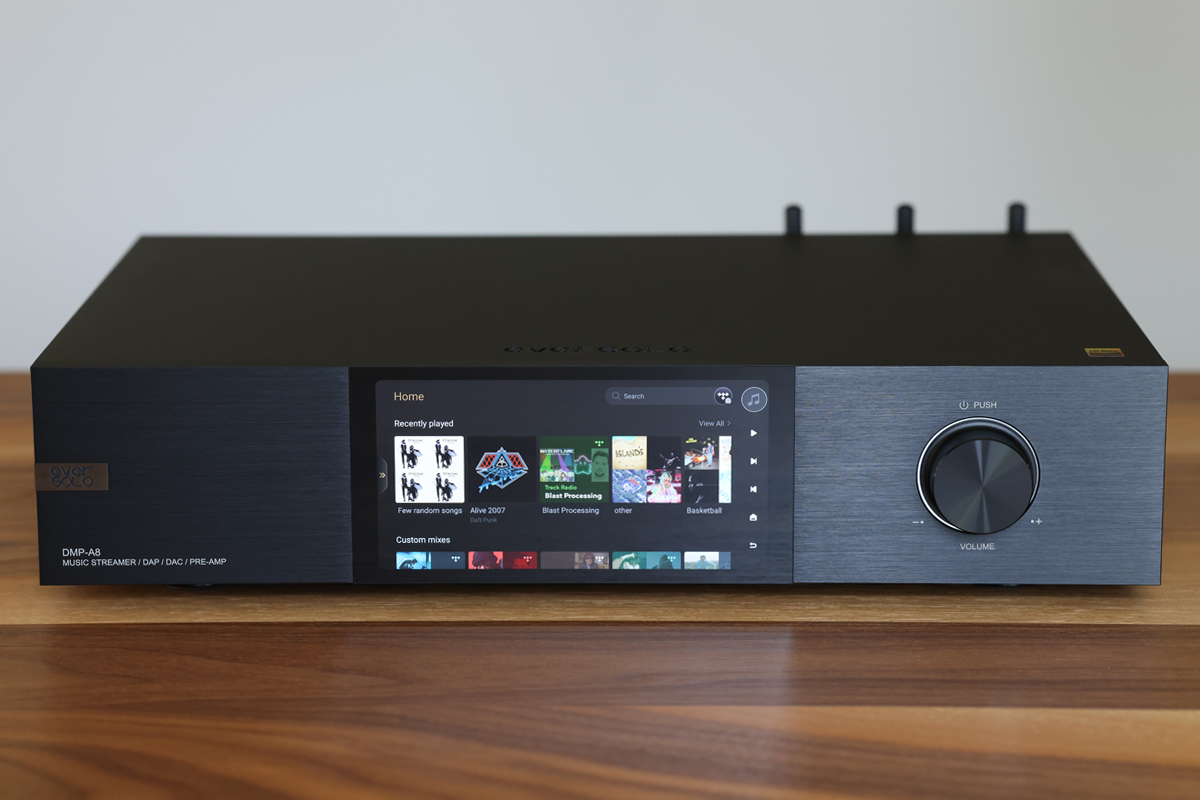Note: for the full suite of measurements from the SoundStage! Audio-Electronics Lab, click this link.
 I hadn’t heard much about Eversolo before receiving the DMP-A8 for review. I saw some online chatter around the time this product was released and some early reviews, but I knew very little about Eversolo except that it was the relatively new audio brand of Zidoo, which has been producing high-quality video media streamers for several years.
I hadn’t heard much about Eversolo before receiving the DMP-A8 for review. I saw some online chatter around the time this product was released and some early reviews, but I knew very little about Eversolo except that it was the relatively new audio brand of Zidoo, which has been producing high-quality video media streamers for several years.
The DMP-A8 joins the previously introduced DMP-A6 and its Master Edition variant to become the company’s top-of-the-line streamer. The DMP-A8 has generated a lot of buzz in the computer audiophile community, and for good reason. On paper, it appears to offer exceptional value: advanced engineering, high-quality parts, and robust build quality for the reasonable price of $1980 (all prices in USD). The Expert Imaging and Sound Association (EISA) agrees, bestowing on it a 2024–2025 Best Product award in the Streamer category.
What’s in the box—and what isn’t
Unboxing the DMP-A8, I found the aluminum casework to be satisfyingly solid and nicely finished with a brushed matte-black front panel and frosted anodized body. The Eversolo logo is engraved in the top panel and in a small silver insert on the left of the front panel. Underneath, the model number and some wording encapsulating the A8’s functionality: “MUSIC STREAMER / DAC / DAP / PRE-AMP.” Multiple heat-sink fins span each side of the unit, projecting a sense this device means business; but overall, I found the design clean and uncluttered, and the construction quality surprisingly good considering its price. An illuminated knob on the right side, the only physical control on the front panel, controls power functions and volume. The rest of the functions may be accessed through the 6″ color LCD touch panel, the Eversolo app (available for Android and iOS) or Roon (the DMP-A8 is Roon Ready), or the small plastic remote.
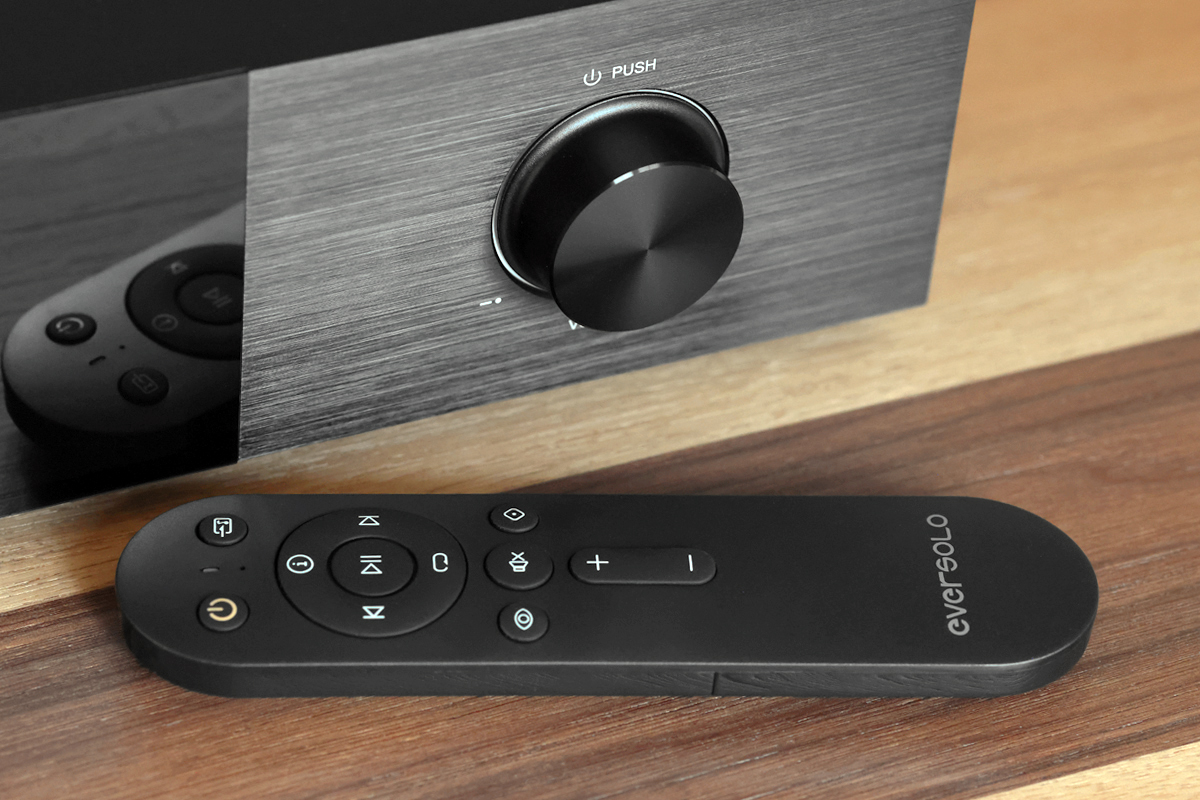
The back panel has one set each of analog inputs and outputs on both balanced XLR and single-ended RCA jacks. Digital inputs include two each of optical TosLink and coaxial RCA, an HDMI ARC, a USB-B for PC audio, and a USB-A for connection to an external storage device, an optical disc drive, or a PC. Digital outputs are available on USB-A for connection to an external DAC, IIS over HDMI (PCM/DSD), optical TosLink, and coaxial RCA. A gigabit ethernet connection is provided, dual antennas for 2.4GHz/5GHz dual-band Wi-Fi, a single Bluetooth antenna, and a 12V trigger output. The IEC AC receptacle is situated next to the mains power switch. The unit is designed to work with voltages from 110 to 240V. An optional M.2 2280 NVMe SSD of up to 4TB can be installed in a compartment on the underside of the case.
The DMP-A8 is not extravagantly overbuilt as some luxury audiophile products of this type are. But its tidy internal layout, high-quality parts, and solid construction are truly remarkable for the price. It utilizes an AK4499EX/AK4191EQ two-chip DAC solution from AKM, along with dual high-precision femto clocks from Accusilicon to reduce jitter. It incorporates capacitors from WIMA, Murata, and Nichicon; Omron relays; and TI op amps. Combined with its XMOS XU316 audio processor, the DMP-A8 supports up to 32-bit/768kHz PCM and DSD512 via USB, Wi-Fi, and ethernet; up to 24/192 PCM and DSD64 DoP (DSD over PCM) via coaxial and optical S/PDIF; and up to 24/192 PCM via HDMI-ARC. It has MQA decoding capability. A Qualcomm QCC5125 Bluetooth module supports the SBC, AAC, aptX, aptX LL, aptX HD, and LDAC codecs.

An ultra-low-noise switching power supply is provided for the digital section and a linear power supply with a multi-winding toroidal transformer for the analog circuits. The digital, analog, and power-supply sections are cleanly separated. A fully balanced resistor-to-resistor (R2R) analog volume-control network is said to offer accurate volume control and suppress noise. It’s mated to a fully balanced preamplifier circuit, providing +10dB of gain and low distortion.
The DMP-A8 uses the Android operating system, so Android apps for music services can be installed. Out of the box, the A8 has native support for AirPlay, Spotify Connect, and Tidal Connect. Its media-management system allows playback from attached USB drives as well as over the network, with support for UPnP, NFS, and SMP protocols and access to such services as OneDrive, Dropbox, and WebDAV. Support for Emby and Plex is currently in beta status. Supported file formats include WAV, FLAC, MP3, APE, AIF, AIFF, AAC, NRG, CUE, DSF, DFF, and SACD ISO.
A notable feature of the DMP-A8 is its use of Eversolo’s proprietary EOS (Eversolo Original Sampling Rate) Audio Engine, which overcomes the Android operating system’s limitations and allows apps such as Apple Music and Amazon Music to output audio files at their original sampling rate. It also supports optical disc drives, allowing for CD playback and ripping. Incoming digital signals are resampled to 48kHz when utilizing DSP. DSP functions include parametric equalization, gain, loudness compensation, compression, delay, and both high- and low-pass filters. Finite impulse response (FIR) filters are also supported, and a tutorial is available that explains how to create and upload them using Room EQ Wizard (REW), a free but powerful room-measurement software program. The DMP-A8’s DSP functions work only on digital inputs and the internal player; there is no A-to-D conversion for the analog inputs.
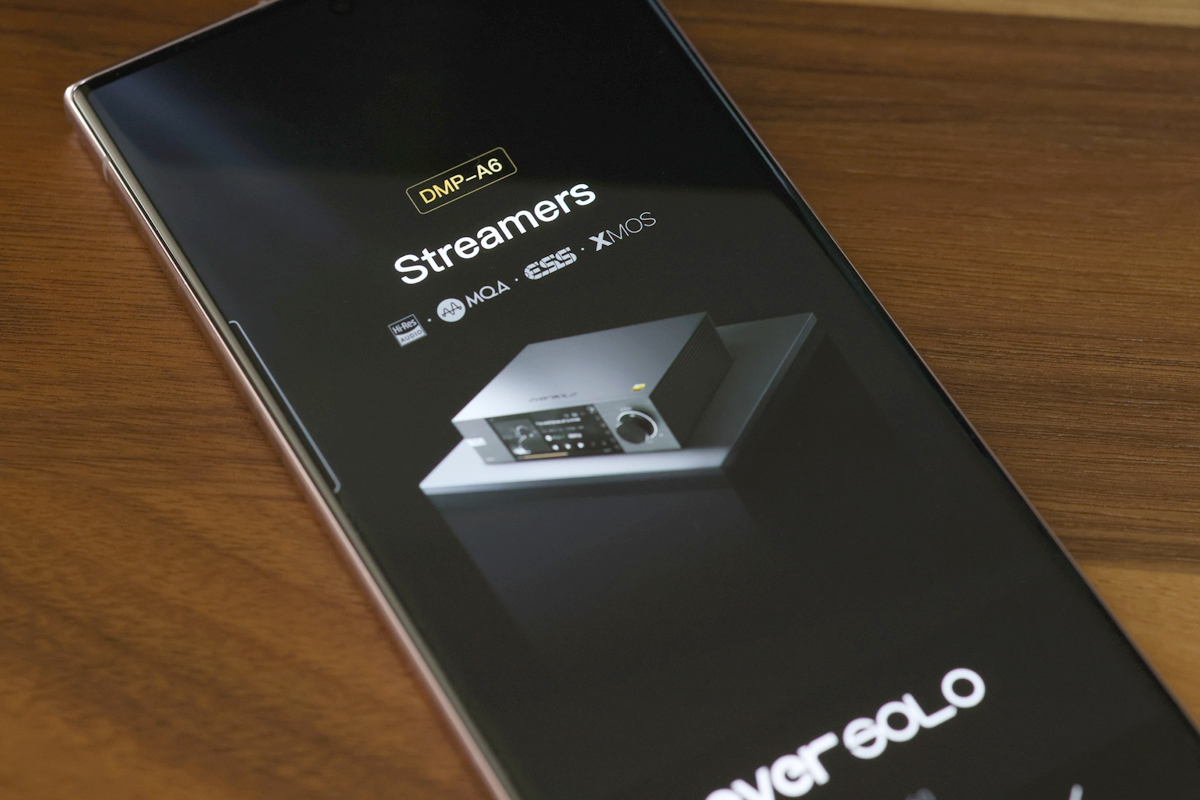
I have to admit that after perusing the DMP-A8’s incredibly impressive specifications and seeing its solid build quality up close, I was awestruck. That it also includes a high-quality R2R analog preamplifier section and a wealth of advanced DSP functions, all for under $2000, was all the more impressive. Eversolo products carry a one-year warranty, which is not so impressive but not unreasonable either, considering their relatively low prices. I couldn’t wait to see if this thing sounded as good as its specs suggested it would.
Getting started
I installed the Eversolo app on my smartphone and connected the DMP-A8 to my home network via an ethernet cable from my router. A QR code generated by the device facilitated its pairing with the phone. Following a few simple steps, I was up and running within minutes.
The front-panel display provides plenty of information, so it can get a little busy. It is not as sharp or bright as displays found on some more expensive streaming products, such as those of the NAD Masters Series. This was especially evident when viewing album-cover art. The remote provides access to all functions, as mentioned, but when sitting at a distance, I found it difficult to navigate the menus and see what was happening on the display. Navigating the menus using the touchscreen display directly was straightforward. I was able to install the Tidal and Amazon apps and would have been able to install Android apps for other streaming services, too, such as Qobuz and Apple Music. Several themes are available for the display, with different layouts of information and different styles of VU meters and spectrum analyzers.
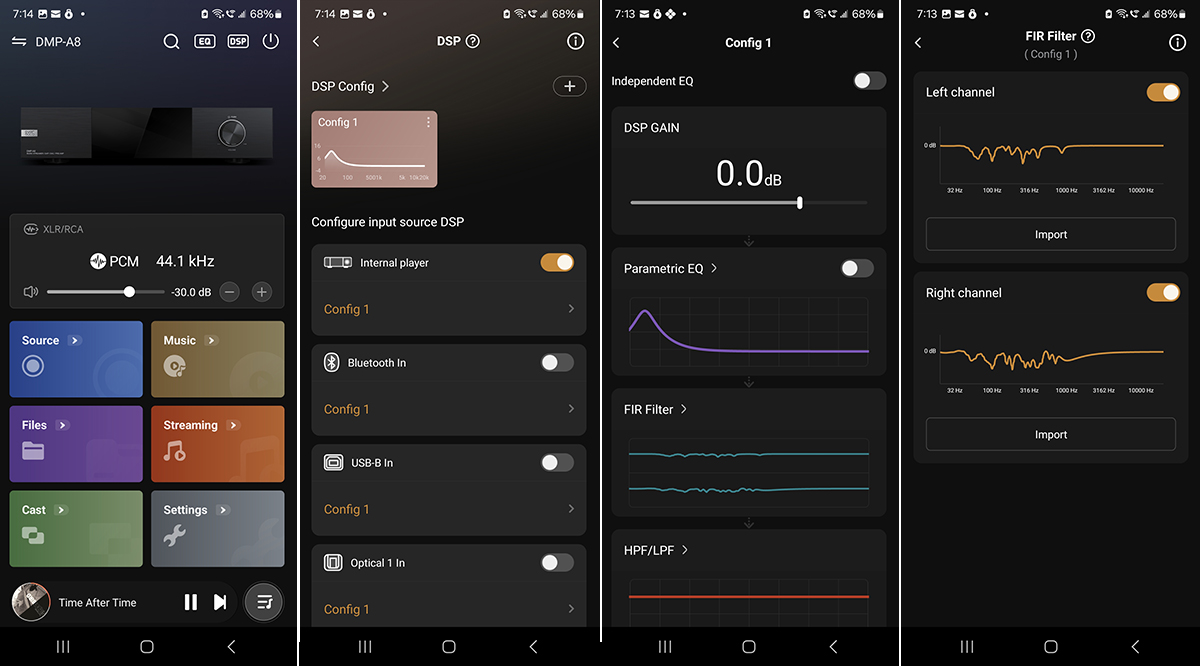
The Android version of the Eversolo app worked well, providing easy control of the unit’s functions and plenty of information on its operating status. The main screen provides access to the various sources and settings as well as to DSP and EQ functions, with further adjustments available on subsequent pages. I was able to find and access every function with ease, including those related to ripping CDs. Only installation of filters, as far as I could tell, cannot be accomplished through the app. And while it is intuitive and easy to use, it is not quite as user-friendly or polished as class-leading streaming platforms such as Roon or BluOS.
I already have all of my CDs ripped to hard drive, but I still connected an Asus USB Blu-ray drive to test CD playback and ripping. A track numbering option may be enabled when ripping, which I did, but it slows down the process significantly. (A warning to that effect displays prior to beginning each rip.) Music playback is paused during this process. Cover art was successfully located during ripping and playback. Gapless playback, an important feature to many, is supported. You can store music files in a high-capacity (up to 4TB) M.2 2280 SSD, as mentioned, or set up network or USB-connected storage for a large music library. Storage of music files and FIR filters is also possible on an onboard eMMC chip (64GB).
Other than to install FIR filters I had generated with REW, I did not use any of the DMP-A8’s EQ or DSP functions. Using REW to generate and upload FIR filters is certainly not as simple as the automated processes provided by dedicated room-correction software, such as Dirac Live, offered on some audio components. But following the information provided in the REW tutorial, even novice users should be able to accomplish this task with relative ease. After using REW to take measurements and generate the response filters in WAV format for the right and left channels, I set up DSP for the internal player and then imported and activated different filters. After some experimentation, I settled on filters based on the Harman response curve (using target curve files provided by SoundStage! measurement specialist Diego Estan) and set the maximum frequency for correction to 1000Hz.
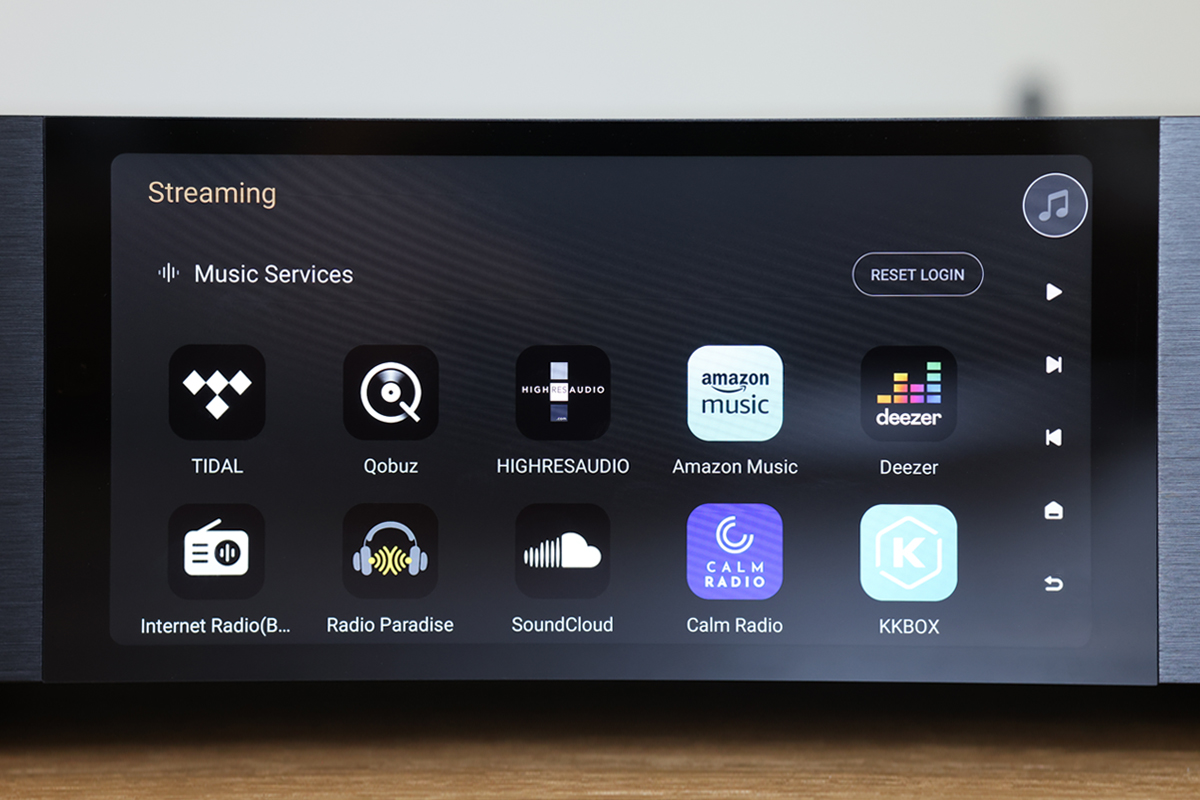
One puzzling omission in the DMP-A8’s implementation of high- and low-pass filters is that there are no dedicated subwoofer outputs, and the filters cannot be assigned separately to the XLR and RCA outputs. Thus, the filters are applied to all outputs when activated. The inability to assign different filters to different outputs may conceivably be rectified in a future firmware update, but currently the ability to apply low- and high-pass filters is of limited usefulness.
The Eversolo DMP-A8 replaced an Anthem STR preamplifier usually found in this system. As usual, the rest of my system consisted of a pair of MartinLogan Masterpiece Classic ESL 9 hybrid electrostatic loudspeakers (which I reviewed in 2017), a Lyngdorf MXA-8400 multichannel power amplifier (which I reviewed in June, this year), used in bridged mode, and a Beelink Windows mini PC running Roon to stream Tidal and locally stored audio files. I also used my Samsung Galaxy A21 smartphone. I left my two JL Audio E-Sub e112 powered subwoofers disconnected since the Eversolo lacks bass management. Cabling and power products were an assortment from Shunyata Research, Analysis Plus, Clarus Cable, Essential Sound Products, Zero Surge and Blue Circle Audio.
Operation and sound
When playing CDs, it took a few seconds for the Asus USB Blu-ray drive to recognize each disc. This drive is not particularly quiet, which did not instill much confidence in the quality of the data stream being fed to the DMP-A8—even though I know that optical drives have excellent data-integrity measures. A full-size optical drive with its own power supply might make playback and ripping quieter and faster. Still, if you want to use the Eversolo to rip the occasional CD, or even play CDs in real time, the option is there for you.
I used the DMP-A8 primarily as a Roon endpoint, but as mentioned, I also played CDs and locally stored files. Everything functioned smoothly, except that the Eversolo’s Music Player app was slightly sluggish navigating an external USB drive containing a few thousand audio files in a few hundred folders.
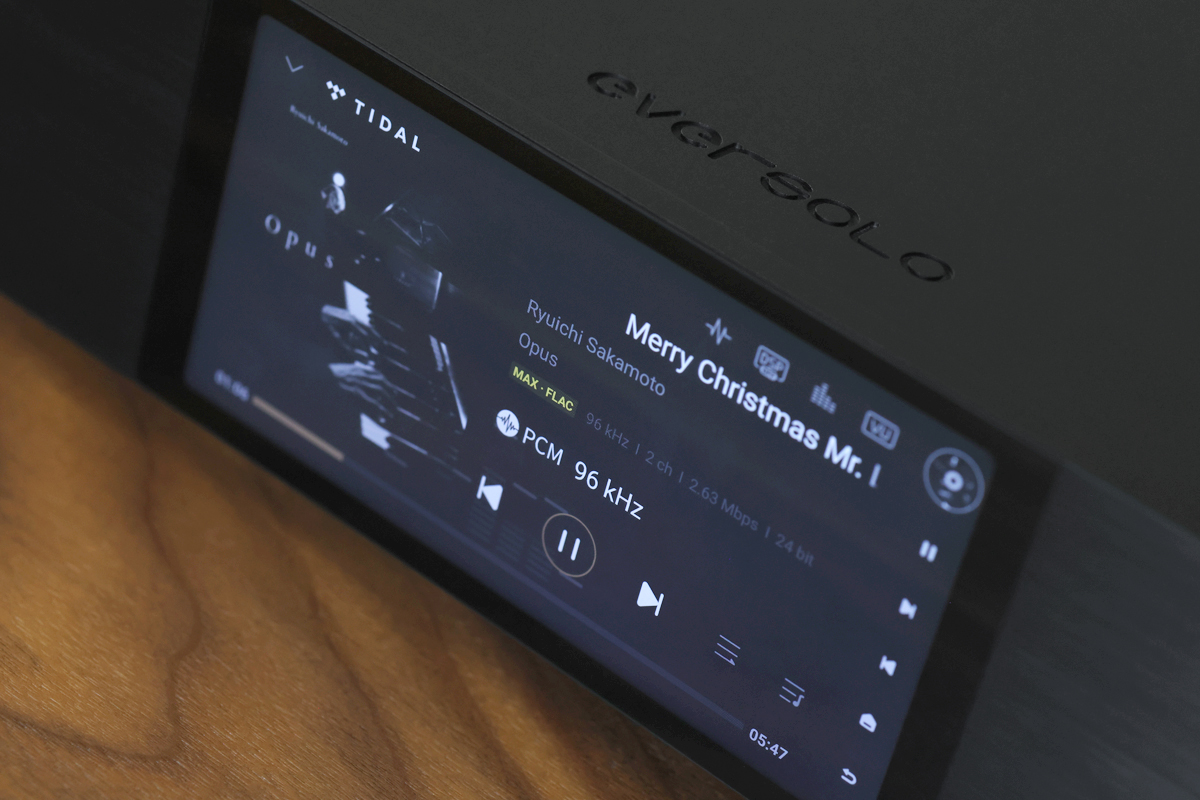
The late Ryuichi Sakamoto’s final recording session is documented in the black-and-white film Ryuichi Sakamoto: Opus and its accompanying soundtrack album. This solo piano recital is a carefully curated collection of Sakamoto’s compositions spanning more than 40 years and is exquisitely captured in this recording. On “Merry Christmas Mr. Lawrence,” from the soundtrack album (24-bit/96kHz FLAC, Milan Records / Tidal), Sakamoto’s piano sounded bold and present and infinitely nuanced, even during the quietest passages. With the DSP FIR filters engaged, the lowest registers were rendered cleanly and uniformly against a dead-silent background.
The following, final track of the album, “Opus – Ending," came through with incredible realism. It sounded as if the piano were ten feet in front of me, in a large acoustic space with no walls around. The exquisite quality of presentation of “Tong Poo,” from Sakamoto’s early Yellow Magic Orchestra era, allowed me to really appreciate his more mature acoustic arrangement of this technopop classic. The caliber of both the performance and recording make this an absolute must-listen for fans of Sakamoto. It sounded spectacular with the Eversolo. I can’t wait to get a physical copy of the Criterion Blu-ray release of the film, later this year.
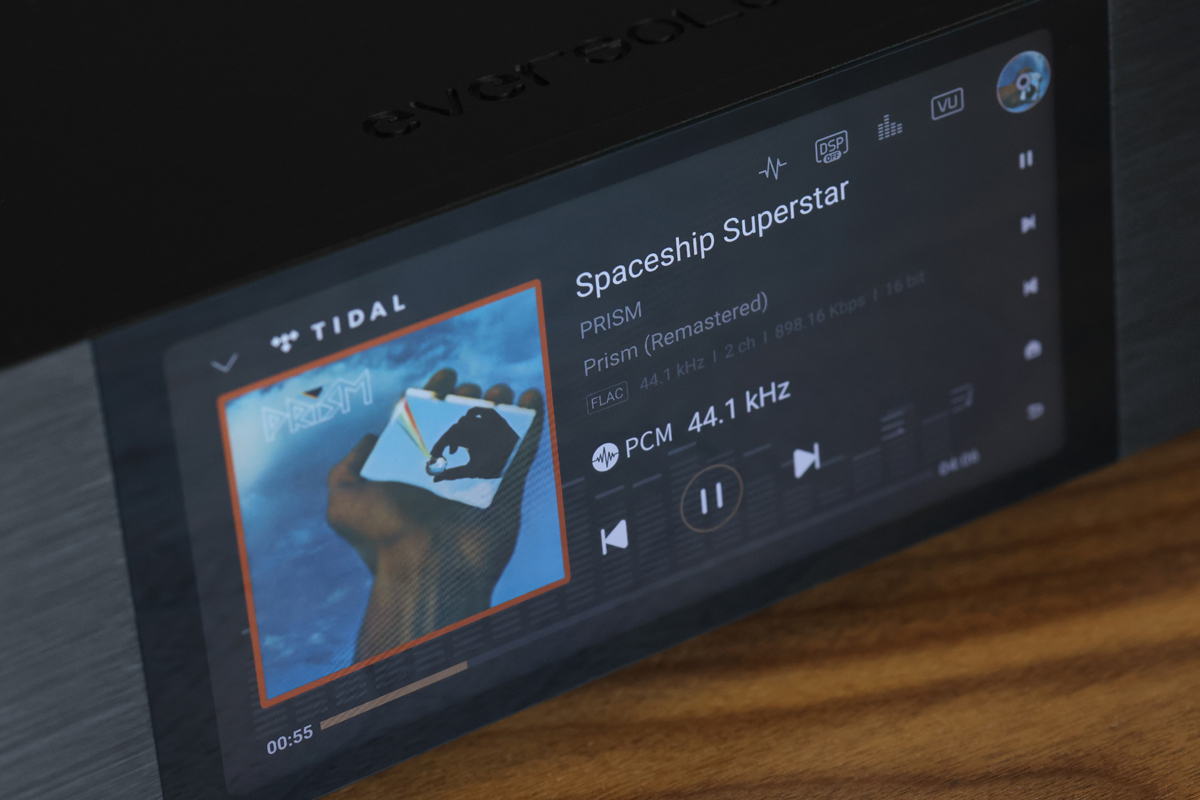
On acoustic recordings like Opus, the effect of the FIR filters was often subtle. It was clearly evident on “White Wedding,” from Billy Idol’s self-titled album (24/96 FLAC, Capitol Records / Tidal). Engaging the filters resulted in the entire presentation being pushed slightly back in the soundstage, but it became much clearer, especially in the lower frequencies. I was better able to differentiate the position of the kick drum from that of the bass guitar, the lead guitar from the rhythm guitars. Playing another rocker, “Spaceship Superstar,” from Prism’s eponymous debut album (16/44.1 FLAC, EMI Records / Tidal), the almost orchestral sound of future super-producer Bruce Fairbairn’s arrangements and the operatic quality of Ron Tabak’s vocals were stunningly clean and precisely conveyed through the DMP-A8.
It’s been 25 years since I first listened to an Eva Cassidy album, based on a recommendation from then fellow SoundStage! Network contributor Ian White. Live at Blues Alley (16/44.1 FLAC, Blix Street / Tidal) is a recording of Cassidy’s 1996 live performance of jazz standards and pop classics made one evening at the Blues Alley jazz club in Washington, DC, and remains one of my favorite recordings. (Eva Cassidy died of cancer shortly after recording Blues Alley.) I recently discovered the 2015 release of Nightbird (16/44.1 FLAC, Blix Street / Tidal), an album comprising all 31 tracks from that Blues Alley session, and a couple of previously unreleased tracks, all remixed and remastered from the original tapes. It is a wonderful recording and the definitive release of her performance that night in 1996—arguably, of her career.
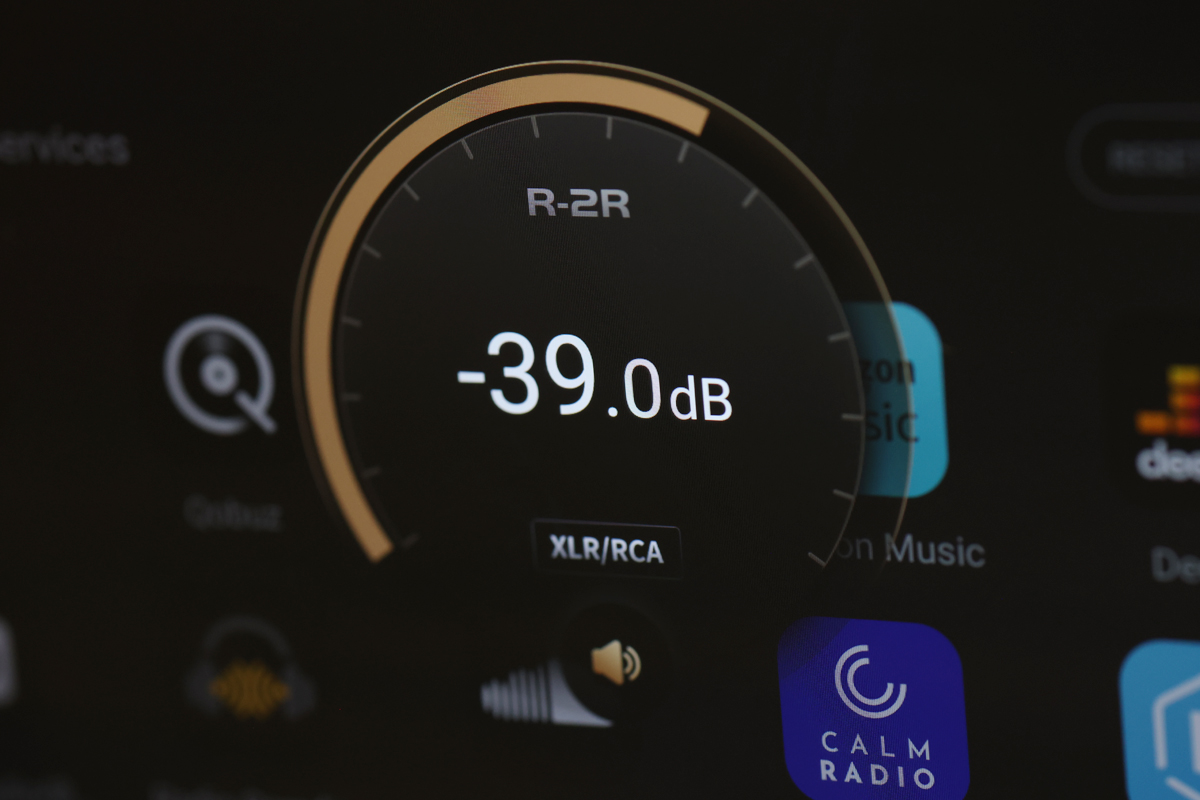
The DMP-A8, in combination with the reference components of my system, highlighted Cassidy’s amazingly expressive vocal style and enhanced the intimacy of the recording. The previously unreleased title track, a cover of Doug MacLeod’s “Nightbird,” features the gorgeously languid guitars of Cassidy and Keith Grimes, which were floating behind, framing her sublimely ethereal phrasing of MacLeod’s lyrics. The flawlessly clear presentation of the vocals and instruments, close together as they were yet perfectly separate, and the sense of acoustic space generated from the recording re-created a measure of the atmosphere in that small club that night, which made for a spine-tingling experience. And when the playing and vocals got raucous, I could still distinctly make out each beat of Raice McLeod’s drum fills even though they were set well back behind Cassidy and the rest of the band.
To stream or not to stream
My reference Anthem STR preamplifier (reviewed by Diego Estan in April 2020) does not have any streaming functionality, but it is equipped similarly to the DMP-A8: it has a high-quality DAC, an analog preamplifier section (though one with an IC-based volume control), and a powerful DSP engine with Anthem’s proprietary ARC Genesis room-correction system. The STR does have the advantage of a more functional bass-management system, but it is priced substantially higher, at $4299.99. Even so, the Eversolo held its own when compared to the Anthem.
The sparse opening notes of “Merry Christmas Mr. Lawrence” sounded indistinguishable on the two preamps, but when the deeper, richer harmonies rolled in, the Anthem sounded even more spacious—not only the walls disappeared, the room itself seemed to expand. Similarly, “Fields of Gold,” from Eva Cassidy’s 1998 album Songbird (CD, Blix Street G2 10045), was excellent with both preamps, but again, the Anthem was slightly more balanced and had more air and sparkly highs that made Cassidy’s voice wonderfully lucid. The Eversolo had a touch of sibilance to its presentation of this track, which was not objectionable, but it did make vocals a little dry in comparison.
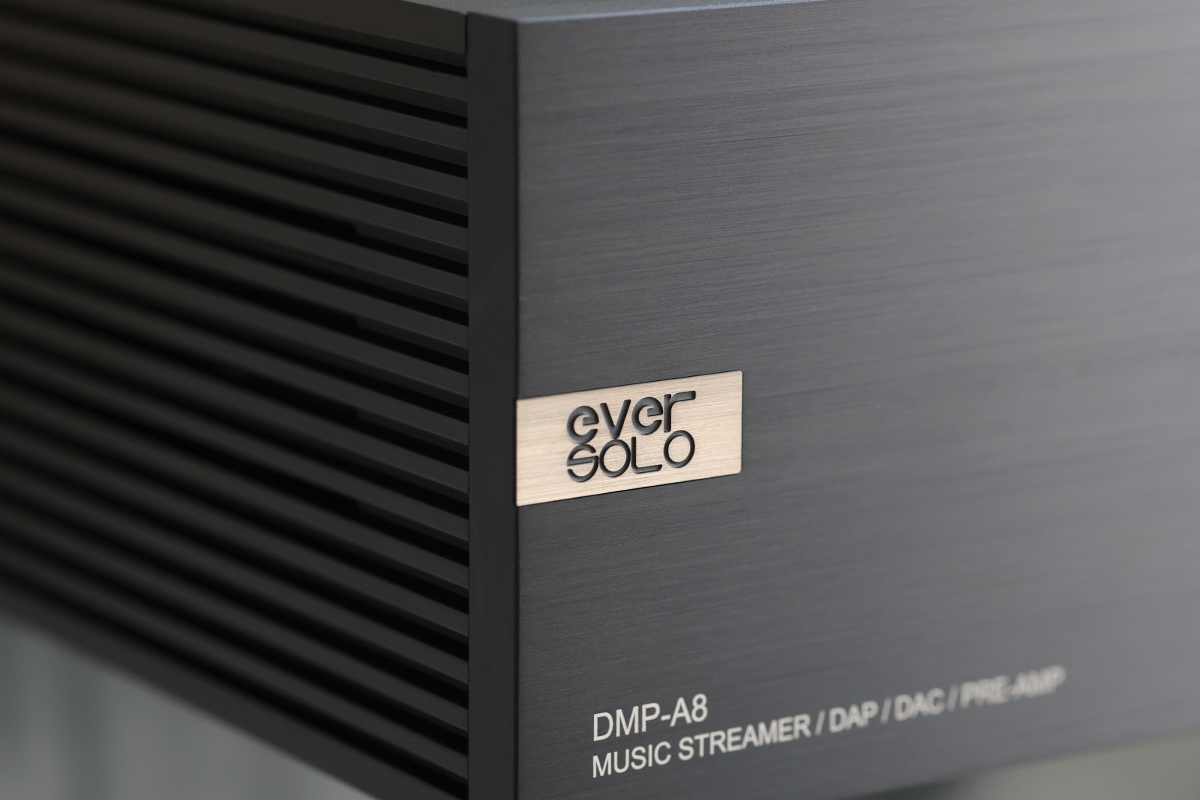
With the somewhat opaque production of “La Femme Chinoise,” from Yellow Magic Orchestra’s eponymous album (DSD64 DSF, GT Music / Alfa), I was not able to consistently differentiate between either preamp’s rendering of the kick drum and synth bass lines that are intertwined with the up-tempo techno melodies. But the more open sound of the 2018 version of the band’s 1979 album Solid State Survivor (24/96 FLAC, Sony Music / Tidal), remastered by Bob Ludwig, was better reflected by the Anthem, as revealed on “Rydeen,” where the synth effects were bouncing wildly between the speakers; the Eversolo seemed to be a bit more restrained. My overall impression was that while the Eversolo’s presentation was exceedingly clear and ultra-quiet, it was just not as involving as that of the Anthem.
Forever Eversolo
I usually find streaming products quite tedious to review due to the many permutations of system configuration available with multiple source and streaming options and to the time required to investigate them. The Eversolo DMP-A8, however, was an absolute pleasure to review thanks to its solid construction, stable operation, and excellent sound quality, no matter how I configured it in my system. For all that it offers, its price is almost unbelievably low, and listening to such a well-executed and high-value streaming preamplifier was always enjoyable.
. . . Roger Kanno
Note: for the full suite of measurements from the SoundStage! Audio-Electronics Lab, click this link.
Associated Equipment
- Speakers: MartinLogan Masterpiece Classic ESL 9
- Preamplifier: Anthem STR
- Power amplifier: Lyngdorf Audio MXA-8400
- Digital sources: Beelink Mini PC running Windows 11, Roon, and Tidal; Samsung Galaxy S21 Android smartphone
- Speaker cables: Analysis Plus Chocolate Oval 12/2
- XLR interconnects: Shunyata Research Venom-X
- Power cords: Clarus Cable Aqua, Essential Sound Products MusicCord-Pro ES
- Power conditioners: Blue Circle Audio PLC Thingee FX-2 with X0e low-frequency filter module, Zero Surge 1MOD15WI
Eversolo Audio DMP-A8 streaming preamplifier
Price: $1980
Warranty: One year, parts and labor
EverSolo Audio Technology Co., Ltd.
Chentian Stock Building Floor 13
Dingjunshan Film Technology Industrial Park
Baotian First Road, Xixiang Avenue
Baoan District, Shenzhen
China
Phone: +86 755 23500280
Email:
Website: www.eversolo.com



